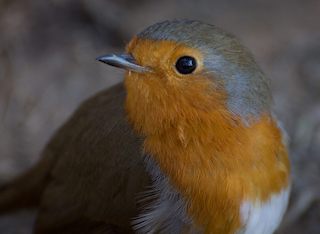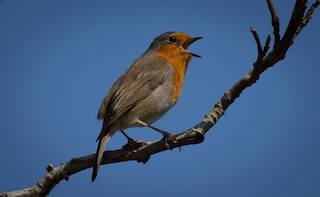 While some birds depart The Lizard for warmer climates in the autumn, others stay with us, including the Robin, cheering us up with its song all through the autumn and winter.
While some birds depart The Lizard for warmer climates in the autumn, others stay with us, including the Robin, cheering us up with its song all through the autumn and winter.
Photo: Amanda Scott
Scientific name: Erithacus rubecula
Other common names: European Robin, Robin Redbreast, Ruddock, English Robin
Cornish name: Rudhek
Conservation status: UK Birds of Conservation Concern, Green; IUCN Red List, Least Concern
What to look for:
- Colouring and appearance: Males and females look the same, with brown back, pale belly, thin legs and the famous red breast (which is absent in juveniles).
- Size: Length 12.5 to 14 cm, wingspan 21 cm.
- Where: The Robin’s distribution includes most of Europe, and parts of northern Africa, Siberia and Turkey. In the UK it is only absent from the Scottish uplands and from islands.
- Call: Tuneful and complex song; also ‘tic-tic’ calls.
- Similar species: The Robin’s red breast means it is easily recognisable, though, when hidden amongst vegetation, it may be mistaken for the less common and plainer looking Nightingale.
 We all love Robins, with their red breasts, perky manner and bright eyes as they follow us round our gardens, waiting for earthworms and other tasty treats to be unearthed. Their bright fluting song is one of the first to open the dawn chorus and one of the last to finish the day. They may even sing during the hours of darkness, if disturbed or if prompted by streetlights. Robins can be heard singing almost all year round: their only song-less period is during their late summer moult.
We all love Robins, with their red breasts, perky manner and bright eyes as they follow us round our gardens, waiting for earthworms and other tasty treats to be unearthed. Their bright fluting song is one of the first to open the dawn chorus and one of the last to finish the day. They may even sing during the hours of darkness, if disturbed or if prompted by streetlights. Robins can be heard singing almost all year round: their only song-less period is during their late summer moult.
Both male and female Robins sing, and they do not, of course, sing for our delight (delightful as it is) but to mark their territory, and the Robin is an aggressively territorial bird. As well as protecting their territory and nest during the breeding season, Robins, one of the few birds with a winter territory, sing through the winter, usually from a branch within the cover of a shrub or tree. This is why you often hear the song before spotting the bird itself as it hops from branch to branch. Robins from neighbouring territories can sometimes be heard having ‘sing-offs’ as they clearly lay claim to their own borders. In the spring, males have a powerful song, louder than the females, as they set out to attract a mate. The autumn and winter song, which is taken up after the late summer moult, is less exuberant, though still beautifully tuneful, and more similar in volume between males and females.
 Individuals hold their own winter territories, but the pair defends the breeding territory in spring and summer, producing two broods per year (occasionally three). The cup-shaped nests are built using leaves, moss and hair in a bank, hole or vegetation, often close to the ground. Robins are creative in their choice of locations – they have been known to nest in pockets. After the young have hatched, the male brings food to the nest for the female to feed to the chicks.
Individuals hold their own winter territories, but the pair defends the breeding territory in spring and summer, producing two broods per year (occasionally three). The cup-shaped nests are built using leaves, moss and hair in a bank, hole or vegetation, often close to the ground. Robins are creative in their choice of locations – they have been known to nest in pockets. After the young have hatched, the male brings food to the nest for the female to feed to the chicks.
The Robin is surrounded by folklore. It used to be a common belief that the Robin and the Wren were the male and female of the same species (hence Cock Robin and Jenny Wren).
Did you know…?
…The Robin’s red breast is pretty to our eyes, but amongst Robins it is actually a cue for territorial defence. The birds will attack patches of red and clumps of red feathers.
…When the postal service first began in the nineteenth century, postmen were known as Robins because of the red waistcoats they wore.
More information and references:
Svensson, L., Mullarney, K., Zetterstrom, D.,1986. Collins Bird Guide, second edition (translated by Christie, D., Svensson, L.). HarperCollins, London.
Published: October 2014 (updated August 2020)
Author: Amanda Scott
Photos: Amanda Scott
